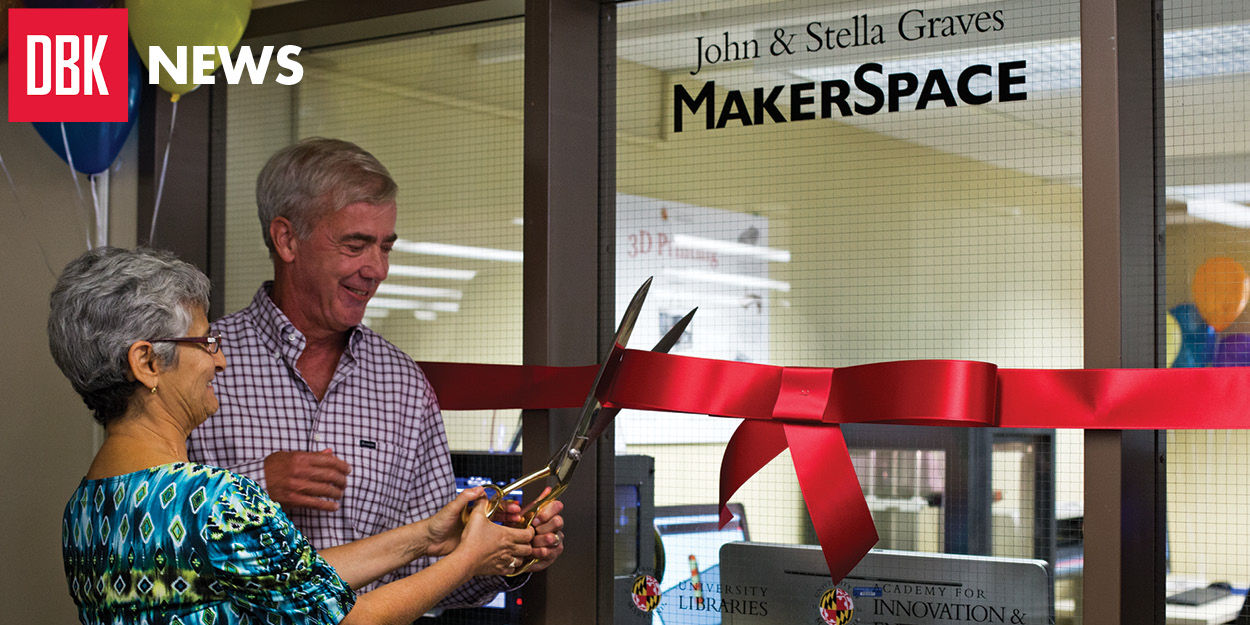
It starts with plastic tchotchkes, such as Testudo statues and Pikachu figurines, and extends beyond virtual reality video games and operating room communication via Google Glass.
It’s the ‘maker movement,’ and it’s received its own resource room — dubbed the John and Stella Graves MakerSpace — in a repurposed study room on McKeldin Library’s second floor.
Donors John and Stella Graves cut the ribbon Monday afternoon in front of about 25 students, faculty and staff to mark the official opening of the new space.
The MakerSpace supports the trending use of new technologies for creation and innovation purposes, said Dean Chang, associate vice president for innovation and entrepreneurship. The room includes 3-D printers and scanners, Google Glass, a vinyl cutter and Oculus Rift, a set of virtual reality goggles developed by the company headed by university alumnus Brendan Iribe.
Patricia Steele, the dean of libraries at this university, spoke to visitors about the potential for the new MakerSpace and the opportunities it offers all students — not just those in programs that own similar technology. She stressed that it represented a library system that was evolving into something “much more than books.”
“Among the top 125 research universities, only 13 percent have MakerSpaces,” Steele said in her welcome speech. “That really puts us in a special place.”
Earlier this year, President Obama held the very first White House Maker Faire to celebrate the Maker movement and the potential for new technology and invention in nurturing students to solve problems, Chang said. He looked forward to students at this university becoming a part of that movement.
“It is really significant and exciting,” Chang said. “There hasn’t been a space or equipment open and available to all students like this before.”
At Monday’s event, staff showed off how the technology could be used, making miniature Testudo statues and terrapin-shell printed iPhone cases. Attendees also got the opportunity to try on the virtual reality goggles and Google Glass, a technology that students will soon be able to rent with their university IDs, said Preston Tobery, information technology specialist.

Currently, the room is available by appointment, which faculty, staff and students can make online through the library’s website. Use of 3-D printing includes a materials fee of $0.20 per gram of plastic. The room has a staff to assist those using its technology and the library also maintains a Web page with tutorials on using the gadgets.
Robbie Adkins, a freshman computer science major who attended the event, said he wasn’t familiar with much of the technology, but looked forward to the chance to try it out, including the 3-D printer.
“I really want to try and use it, as soon as I can come up with a good enough idea of what to print,” he said.
Cynthia Harris, a library technician, said students can also participate in a digital badge program. They can create a project using the technology in the MakerSpace and submit it to the library staff for review to earn a badge.
“And my favorite part, though I haven’t tried them yet, is the Oculus Rift,” Harris said. “Virtual reality really seems like the next step in the field of technology. I’m really curious about it; it seems pretty cool.”
John Graves, one of the namesake donors, said he wasn’t sure whether he was the kind of person who would use MakerSpace, but he was happy to be a part of this opportunity for students and looks forward to “great success in the future.” Officials will add new technologies as they evaluate student interest, and some in attendance had already expressed excitement over the MakerSpace’s features.
“I can’t wait to make my first thing,” Chang said.



